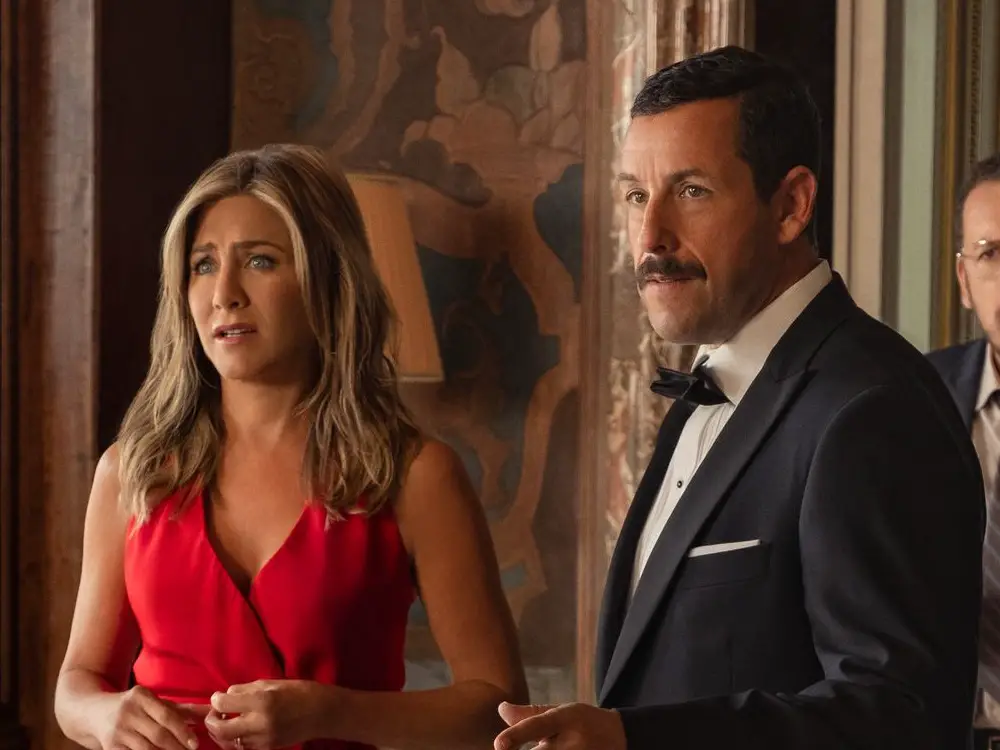Film aficionados are familiar with the plot of the old-fashioned murder mystery movie: first, the hero, who’s typically a plucky individual with humble roots, stumbles upon a group of aristocrats. The glitz and glamour of wealth consumes the protagonist’s attention; silk dresses, sparkling champagne and priceless family heirlooms fill the scenes, and characters stroll through lush gardens, sharing secrets with the newcomer. Shifty-eyed servants warn the hero to mind their own business, and it isn’t long before someone is murdered, and the household falls apart.
Recently, Netflix released a star-studded parody of this classic story. “Murder Mystery,” starring Adam Sandler and Jennifer Aniston, “broke the company’s record for viewing during its first three days.” Over 30 million viewers watched the crime-comedy, prompting a flood of online reviews and commentary. For the most part, critics dislike the cliché adventure. Fans, however, praise the movie’s enthralling plot and lighthearted vibe.
So, is “Murder Mystery” a worthy addition to your weekend movie marathon?
The film begins in New York, where viewers meet Nick and Audrey Spitz. Nick, played by Sandler, is a snarky police officer who has failed his detective exam for the third time, thanks to his test anxiety. Embarrassed, Nick continues to lie to his wife, who thinks he passed the first time.
Audrey, played by Aniston, is a chatty, upscale hairdresser who complains about her marriage to clients, lamenting the relationship’s lack of romance. She reminisces that, 15 years ago, Nick promised to plan a European vacation for the couple, and decides to finally confront her husband about his unfulfilled promise. Feeling cornered, Nick lies once again and theatrically claims that he has already planned the trip.
The dysfunctional couple jump on a plane bound for Europe. They squabble for a few moments, and Nick falls asleep in his seat, so Audrey decides to explore the plane. As she wanders into first class, a suave gentleman, played by Luke Evans, appears in the corner.
The two strike up a conversation, and he eventually introduces himself as Charles Cavendish, the nephew of famous billionaire Malcolm Quince. His former fiancée, he reveals, is now marrying his rich, elderly uncle on a yacht. Cavendish is traveling to Monaco, planning on “getting blind drunk and ruining the festivities,” and invites the Spitzes to join him. Audrey excitedly convinces her husband to ditch their old plan and enjoy the luxurious yacht.
Onboard, Cavendish introduces the lowbrow couple to plenty of eccentric aristocrats. It doesn’t take long for Nick and Audrey to meet the cast of bourgeois characters present in every detective story: millionaires, actresses, decorated war veterans and gold-diggers saunter across the boat. Each guest is waiting impatiently for Malcolm Quince, the main attraction to arrive because, according to rumor, upon his death, one lucky soul will receive 70 billion dollars.
When Quince arrives, he chastises the greedy guests and bequeaths his entire fortune to Suzi Nakamura, his new wife. Then, of course, the lights immediately go out, and an unknown assailant stabs Quince in the back, and Nick and Audrey are the prime suspects in an international murder mystery.
Obviously, “Murder Mystery” is based on a fun and exciting concept, and the classic tropes, first popularized by Agatha Christie, is beloved by fans around the world. However, the movie fails to take advantage of the genre’s best qualities; its larger-than-life characters typically drive the plot of a Christie-esque adventure, because it’s shocking for audiences to see baby-faced debutantes and refined butlers commit acts of violence.
In “Murder Mystery,” viewers only get a brief glance at the suspects, and instead, the movie focuses on Nick and Audrey Spitz. Writers hastily introduce the pair and expect audiences to root for the cliché couple, but the protagonists consistently fail to pique our affection or sympathy.
If viewers are fond of anything, it’s the actors, not their trite characters. Lifelong fans of Aniston can gush about her immortal charm, or once again consider adopting a Rachel Green haircut, and Sandler’s fans can enjoy the comic’s trademark shtick. But despite a few idiosyncrasies, the characters’ personalities are stereotypical and boring.
Typically, in spoofs of widely-known storylines, writers mock the genre’s stereotypes; for example, the famous “Scary Movie” franchise pokes fun at clichés found in most horror films. “Murder Mystery,” instead of taking a parodic tone, unironically follows a cliché couple; Nick is blissfully ignorant of his wife’s resentment and moronically stumbles through life, while Audrey expects Nick to anticipate her needs and becomes belligerent when he fails. The two seamlessly personify the trope of the “awful wedded life,” in which marriage resembles “long, slow, exquisite torture by a sadistic god from whose malicious clutches escape is impossible.”
Overall, “Murder Mystery” does an extraordinary job of highlighting a trite couple, but the movie never resembles an actual parody of a murder mystery.
Its shortcomings aside, “Murder Mystery” manages to contain a few genuinely entertaining elements. Evans, with his debonair manner, brilliantly portrays a snide millionaire; when Audrey questions his decision to attend an ex-fiancée’s wedding, Cavendish remarks elegantly, “I’m a glutton for social masochism.”
Later, as the Spitzes gawk at rich guests, Audrey begins commenting on each one’s appearance, and at one point, she observes, “Oh wow, she’s so pretty! She’s that kind of pretty, that you don’t really know what country she’s from.” To Audrey’s astonishment, the woman turns and sourly informs her that she is from Japan, and Nick remarks, “She can hear you. She’s not on a television right now. You’re watching a real person.”
In such moments, Aniston and Sandler perfectly depict a pair of clueless tourists, marching around in Hawaiian-print garb and taking obnoxious snapshots along the way.
The pair’s charm, however, ultimately fails to overcome mediocre writing. In fact, the intense focus on the couple’s woes actually decreases the movie’s quality. This kind of stereotyped relationship is more at home in a sitcom, but mind-bending whodunnit stories usually avoid such blatant clichés because, knowing intrigue lies around every corner, audiences learn to “expect the unexpected.”
Aniston and Sandler would have been excellent in a well-written parody of the classic storyline; arm in arm, the couple could have poked fun at the genre’s many clichés. Instead, the A-list actors play a cliché, middle-aged couple, and “Murder Mystery” just feels like a missed opportunity.
















